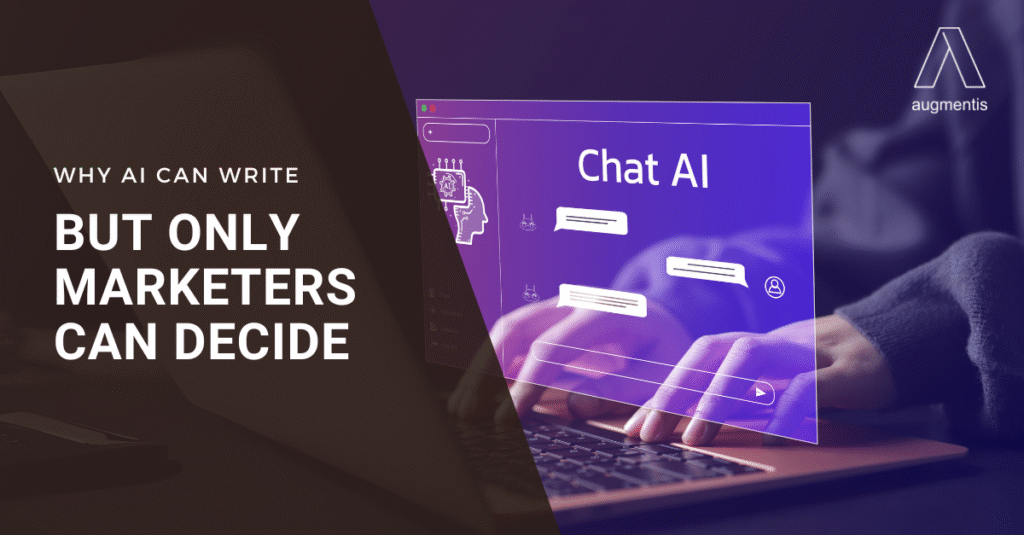
With AI becoming ubiquitous, almost all B2B organisations are pouring significant resources into AI-driven content creation. As per one of the recent studies, 85% of marketers now use AI for content creation.
Overnight, their downloads skyrocket. Whitepapers, blogs, emails, all churned out in record time. The team cheers the volume, but sales quietly stall. Why? Because despite all the hustle, the right people weren’t targeted, and the right problems weren’t prioritised.
This is the danger of speed without judgment: AI can write, but humans must decide what to say, to whom, and why. Without this crucial layer of judgment, AI only accelerates mistakes rather than growth. In the hypercompetitive world of B2B marketing, your true competitive moat isn’t faster content, it’s sharper decisions.
Table of Contents
What Makes Human Judgment Irreplaceable?
AI tools excel at producing B2B content quickly and consistently. They save time, cut costs, and generate ideas when creativity lags. But AI doesn’t understand the nuances of your business, your customers’ unique pain points, or the strategic trade-offs to prioritise.
Without this critical judgment, AI’s speed just floods the market with generic marketing messages aimed at everyone and catches no one.
Savvy B2B marketers build what we call the “Judgment Stack”:
1. Clarifying the Ideal Customer Profile (ICP), who exactly matters to your growth?
2. Ranking the problems your product solves, because not all pains deserve equal ink.
3. Positioning your brand with a clear, differentiated story that resonates.
4. Crafting marketing messages tailored both for the decision-makers and the behind-the-scenes influencers.
5. Picking channels that truly reach and influence your ICP.
AI can churn out the words, but it can’t master this stack. For example, ask ChatGPT for a media plan for your B2B business and it will include Facebook and Instagram. Without understanding that both these platforms are blocked in a majority of your target organisations.
The Critical Three Decisions AI Should Never Control
There are pivotal decisions that demand human discernment. AI excels at outputting B2B content, but deciding what content to create, for which audience, and through which channel is strictly a human game:
1. Choosing Which Segments to Cut Loose
AI favors data volume and broad reach, often at the cost of wasting budget. Seasoned B2B marketers know when to say “no” to certain segments that muddy the funnel without ever converting meaningfully.
2. Elevating the Right Problems
Customers face many pains, but not all matter equally. Highlighting every pain diffuses urgency. Humans identify the few “make or break” issues that truly ignite buying momentum. And considering the long buying cycles in the B2B space, this distinction becomes critical.
3. Knowing When to Pass on a Channel
The latest trendy channel isn’t always the right place for your message. B2B marketers understand where their ICPs engage and influence happens, saying “no” to popular but irrelevant platforms.
How To Use AI Without Losing Judgment?
To build your moat and avoid the blind alley of empty B2B content, follow this disciplined flow:
1. Prompt: Start with a marketing strategy to shape AI prompts grounded in your ICP and prioritised pains.
2. Output: Use AI to strictly generate only the draft content and explore novel ideas.
3. Human Judgment Gate: Evaluate each piece for strategic alignment with your sales and positioning goals.
4. Test: Pilot with focused accounts or segments, gathering data and feedback.
5. Scale: When something truly resonates and accelerates the pipeline, amplify with AI efficiencies.
This flow ensures AI fuels growth with human insight steering the wheel, rather than AI running unchecked into costly noise.
Eight Questions to Test If Your B2B Campaign Passes the Judgment Bar
Before a campaign launches, run this checklist:
1. Have you clearly defined who your Ideal Customer is, and just as importantly, who they are not?
2. Are there segments explicitly excluded to maximise focus and budget efficiency?
3. Have you identified the top one or two problems that your ideal buyers urgently need solved?
4. Is your positioning razor-sharp, addressing those pains uniquely and convincingly?
5. Has messaging been tailored for varying buyer roles across the entire B2B buying committee?
6. Are your channels carefully chosen to prioritise where your buyers actually engage?
7. Did subject matter experts review AI outputs to ensure they’re credible, clear, and on-brand?
8. Is there a clear plan to test your campaign in a controlled way before scaling?
Any doubts here signal it’s time to reinforce your judgment moat before hitting “publish.”
Summing Up
In a world dazzled by AI’s promise, it’s tempting to let machines call the shots. But speed alone won’t unlock revenue forever. Without top-level strategic judgment directing what content AI generates, you risk flooding the market with meaningless messaging that confuses buyers, drains resources, and frustrates sales teams.
True B2B growth comes from making sharp choices over what to say, who to say it to, and how to say it, not simply from saying more. When B2B marketers lead with judgment and AI acts as an enabler, you build a moat that competitors struggle to cross.
Feel free to reach out to us at marketing@augmentis.in to explore how we can help your organisation blend human insights with AI efficiency to drive marketing campaigns that truly move the sales needle.

